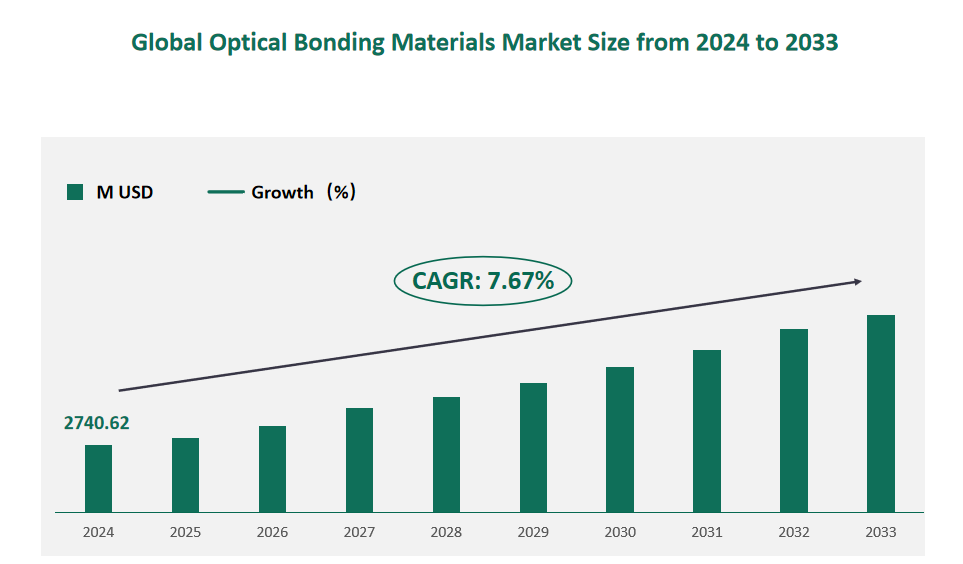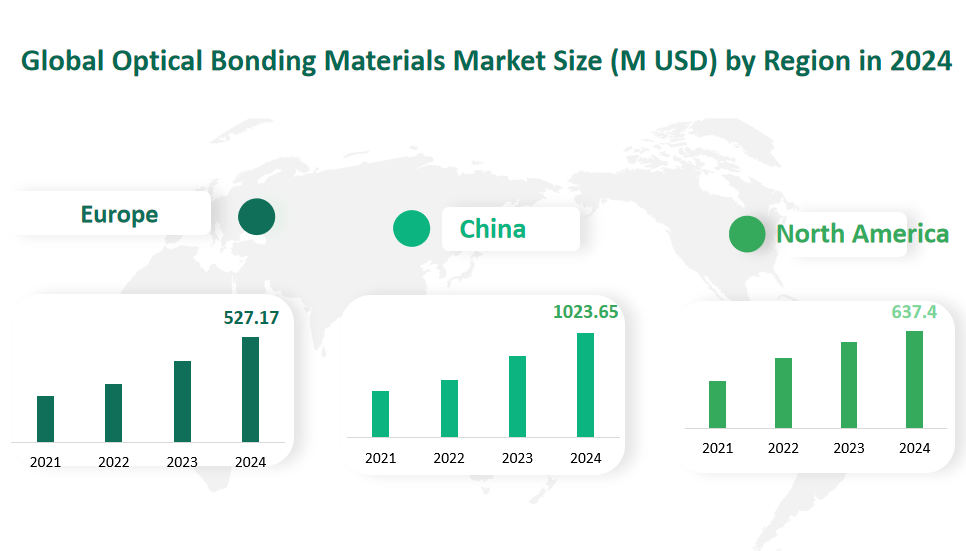1 Global Optical Bonding Materials Market Size (Value) and CAGR (2024-2033)
In 2024, the global Optical Bonding Materials market was valued at USD 2740.62 million, with a CAGR of 7.67% from 2024 to 2033.
Optical bonding refers to a protective glass that is glued in front of a display to enhance its readability where installed in high humidity outdoor environments. When a normal display is used in an outdoor environment, there are some factors that affect its readability. The most common one is “fog”, or condensation, which forms on the inner surface of display’s vandal shield. Another factor is the reflection of sunlight, which causes a mirror-image on the display. Both phenomena can be solved by using optical bonding.
Figure Global Optical Bonding Materials Market Size (M USD) and CAGR 2024-2033

2 Optical Bonding Materials Market Drivers
The Optical Bonding Materials market is propelled by several key drivers that are fueling its growth and expansion across various industries. One of the primary drivers is the rapid development of the global consumer electronics industry. In recent years, this industry has witnessed significant technological advancements, leading to an increased demand for high-performance materials. Optical Bonding Materials offer superior protection and enhanced display performance, making them indispensable for modern electronic devices.
Optical Bonding Materials provide several unique advantages that contribute to their growing popularity. For instance, they enhance the readability of displays in bright environments by eliminating internal reflections between the screen glass and the LCD unit. This feature is particularly important for devices used outdoors or in well-lit settings.
Another significant driver is the increasing demand for high-performance displays in various sectors, including automotive, industrial electronics, and consumer electronics. As technology continues to advance, the need for displays that offer better contrast, clarity, and durability has grown. Optical Bonding Materials meet these requirements by providing a robust and reliable solution that enhances the overall performance of displays.
3 Optical Bonding Materials Market Restraints
Despite its significant growth potential, the Optical Bonding Materials market faces several challenges that could hinder its expansion. One of the primary challenges is the intense competition within the industry. The market is highly competitive, with both international and domestic companies vying for market share. This competition can lead to oversupply, which in turn may result in lower product prices and reduced industry profit margins. Companies must continuously innovate and improve their products to maintain a competitive edge in this dynamic market.
Another significant challenge is the stringent regulatory environment. Governments and industry bodies often impose strict regulations on the production and use of materials in the electronics industry. These regulations are designed to ensure product safety, environmental sustainability, and consumer protection.
The market also faces challenges related to the supply chain. The availability and price stability of raw materials are crucial factors that can impact production costs and profitability. Fluctuations in the prices of key raw materials, such as acrylate, organic silica gel, and epoxy resin, can affect the overall cost structure of Optical Bonding Materials.
4 Global Optical Bonding Materials Market Size and Share by Type in 2024
Acrylate Optical Bonding Materials are highly valued for their excellent optical clarity and high light transmittance. They are particularly suitable for use in harsh outdoor environments where displays need to be highly readable under direct sunlight or bright ambient light. Acrylate materials are known for their resistance to yellowing, which ensures that displays maintain their clarity over time. In 2024, the Acrylate segment is projected to reach a market value of 1064.38 M USD, representing a significant portion of the overall market. This growth is driven by the increasing demand for high-performance displays in consumer electronics and automotive applications.
Epoxy Optical Bonding Materials are known for their strong bonding capabilities. When used as a structural adhesive, epoxy produces a stronger bond than silicone, eliminating the formation of particulate debris that is common in the silicone bonding process. However, epoxy bonding is not repairable, which limits its use in applications where reworkability is required. In 2024, the Epoxy segment is expected to reach a market value of 820.93 M USD. This segment benefits from its use in applications where durability and strength are critical, such as in industrial electronics and automotive displays.
Silicone Optical Bonding Materials are the most common adhesives used in the optical bonding process. They are known for their low conductivity, chemical reactivity, thermal stability, and ability to repel water, forming watertight seals. These properties make silicone an ideal solution for optical bonding. Additionally, silicone’s soft nature allows for reworkability, making it feasible to repair bonds that become damaged over time. In 2024, the Silicone segment is projected to reach a market value of 452.1 M USD. This segment is widely used in consumer electronics and automotive applications due to its versatility and reliability.
Table Global Optical Bonding Materials Market Size and Share by Type in 2024
Type | Market Size (M USD) 2024 | Market Share 2024 |
Epoxy | 820.93 | 29.95% |
Silicone | 452.10 | 16.50% |
Acrylate | 1064.38 | 38.84% |
Others | 403.22 | 14.71% |
5 Global Optical Bonding Materials Market Size and Share by Application in 2024
Consumer Electronics is the largest application segment for Optical Bonding Materials. This segment includes smartphones, tablets, laptops, and other portable electronic devices. Optical Bonding Materials are crucial in enhancing the readability and durability of displays in these devices. In 2024, the Consumer Electronics segment is projected to reach a market value of 1312.71 M USD. This growth is driven by the increasing demand for high-performance displays that offer better visibility in bright environments and improved resistance to scratches and impacts.
Industrial Electronics is another significant application area for Optical Bonding Materials. This segment includes industrial control panels, medical devices, and other electronic systems used in industrial settings. Optical Bonding Materials are used to protect these displays from harsh environmental conditions and to enhance their readability. In 2024, the Industrial Electronics segment is expected to reach a market value of 556.90 M USD. The growth in this segment is driven by the increasing adoption of advanced display technologies in industrial applications.
The Automotive segment is also a major application area for Optical Bonding Materials. This segment includes dashboard displays, infotainment systems, and other automotive electronics. Optical Bonding Materials are used to improve the visibility of displays in vehicles, especially in bright sunlight, and to protect them from environmental factors. In 2024, the Automotive segment is projected to reach a market value of 597.03 M USD. The growth in this segment is driven by the increasing demand for advanced display technologies in automotive applications.
Table Global Optical Bonding Materials Market Size and Share by Application in 2024
Application | Market Size (M USD) 2024 | Market Share 2024 |
Consumer Electronics | 1312.71 | 47.90% |
Industrial Electronics | 556.90 | 20.32% |
Automotive | 597.03 | 21.78% |
Others | 273.98 | 10.00% |
6 Global Optical Bonding Materials Market Size by Region in 2024
North America is a significant market for Optical Bonding Materials, driven by the presence of major technology companies and a high demand for advanced display technologies. In 2024, the North America region is projected to reach a market value of 637.4 M USD. The growth in this region is driven by the increasing adoption of high-performance displays in consumer electronics and automotive applications.
Europe is another major market for Optical Bonding Materials, with a strong demand for advanced materials in the automotive and industrial electronics sectors. In 2024, the Europe region is expected to reach a market value of 527.17 M USD. The growth in this region is driven by the increasing demand for high-performance displays in automotive and industrial applications.
China is the largest market for Optical Bonding Materials, driven by its rapid economic growth and the increasing demand for consumer electronics and automotive applications. In 2024, the China region is projected to reach a market value of 1023.65 M USD. The growth in this region is driven by the increasing adoption of advanced display technologies in consumer electronics and automotive applications.
Figure Global Optical Bonding Materials Market Size by Region in 2024

7 Major Players in Global Optical Bonding Materials Market
7.1 3M
Company Profile: 3M is a multinational conglomerate known for its innovation and diverse product portfolio. Established in 1902, 3M operates globally with manufacturing bases primarily in North America, Europe, and the Asia-Pacific region. The company is headquartered in the United States and is renowned for its commitment to research and development.
Business Overview: 3M’s business spans multiple sectors, including Safety and Industrial, Transportation and Electronics, Health Care, and Consumer. The company’s optical bonding materials are part of its broader portfolio of industrial products, focusing on enhancing display performance and durability.
Products Offered: 3M offers a range of optical bonding materials, including 3M™ Optically Clear Adhesives (OCA) and Contrast Enhancement Films (CEF). These products are designed to provide high optical clarity, strong adhesion, and resistance to environmental factors, making them ideal for use in consumer electronics, automotive displays, and industrial applications.
Recent Financial Data: In the most recent year, 3M reported a revenue of 375.19 million US dollars from its optical bonding materials segment.
7.2 Mitsubishi Chemical
Company Profile: Mitsubishi Chemical is a leading chemical company with a global presence. Established in 2005, the company has manufacturing bases primarily in the Asia-Pacific region and operates worldwide. Mitsubishi Chemical is known for its diverse product portfolio, which includes performance products, healthcare products, and industrial materials.
Business Overview: Mitsubishi Chemical’s business segments cover a wide range of industries, including construction, medical, energy, and petrochemicals. The company’s optical bonding materials are part of its performance products segment, focusing on providing high-quality solutions for display technologies.
Products Offered: Mitsubishi Chemical offers CLEARFIT™, a transparent adhesive sheet used to fill voids in display panels. This product enhances contrast and visibility, making it suitable for touch screens and other display applications. The company also provides other specialized optical bonding materials tailored to meet specific industry needs.
Recent Financial Data: In the most recent year, Mitsubishi Chemical reported a revenue of 312.95 million US dollars from its optical bonding materials segment.
7.3 LG Chem
Company Profile: LG Chem is a leading chemical manufacturer with a strong presence in the global market. Established in 1947, the company has manufacturing bases primarily in the Asia-Pacific region and operates worldwide. LG Chem is known for its diverse product portfolio, which includes petrochemicals, plastic resins, and engineering plastics.
Business Overview: LG Chem’s business segments cover a wide range of industries, including automotive, electronics, and industrial materials. The company’s optical bonding materials are part of its electronics segment, focusing on providing high-performance solutions for display technologies.
Products Offered: LG Chem offers Optically Clear Adhesive (OCA), which is used to bond layers of touch screen panels and displays. This product provides high optical clarity and strong adhesion, making it ideal for consumer electronics and automotive displays. The company also offers other specialized optical bonding materials tailored to meet specific industry needs.
Recent Financial Data: In the most recent year, LG Chem reported a revenue of 219.27 million US dollars from its optical bonding materials segment.

